Aces High Air Manuals
Volume 11: Experimental and Prototype
XB-70 Valkyrie
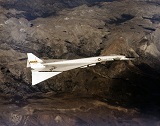
|
North American Aviation XB-70 Valkyrie Flight Manual Part 1
43 pages
The North American Aviation XB-70 Valkyrie is the prototype of the B-70 nuclear-armed, deep-penetration strategic bomber for the U.S. Air Force's Strategic Air Command. In the late 1950s North American Aviation designed the Valkyrie bomber as a large, six-engined aircraft capable of reaching Mach 3+ while flying at 70,000 feet (21,000 m).
At these speeds, it was expected that the B-70 would be almost immune to interceptor aircraft, the only effective weapon against bomber aircraft at the time. The bomber would spend only a few minutes over a particular radar station, flying out of its range before the controllers could position their fighters in a suitable location for an interception. Its high speed also made the aircraft difficult to see on the radar displays, and its high altitude flight could not be matched by any contemporary Soviet fighter. The introduction of the first Soviet surface-to-air missiles in the late 1950s put the near-invulnerability of the B-70 in doubt. In response, the US Air Force (USAF) began flying its missions at low level, where the missile radar's line of sight was limited by local terrain. In this low-level penetration role, the B-70 offered little additional performance over the B-52 it was meant to replace. It was, however, far more expensive and had shorter range. Other alternate missions were proposed, but these were of limited scope. As the strategic role passed from bombers to intercontinental ballistic missiles (ICBMs) during the late 1950s, manned bombers were increasingly seen as obsolete. The USAF eventually gave up fighting for its production, and the B-70 program was canceled in 1961. Development was then turned over to a research program to study the effects of long-duration high-speed flight. As such, two prototype aircraft were built, and designated XB-70A; these aircraft were used for supersonic test-flights during 1964–69. In 1966, one prototype crashed after colliding in mid-air with a smaller jet aircraft; the remaining Valkyrie bomber is in the National Museum of the United States Air Force near Dayton, Ohio. |
X-3 Stiletto

|
Douglas X-3 Stiletto Flight Operating Instructions Part 1
21 pages
The Douglas X-3 Stiletto was a 1950s United States experimental jet aircraft with a slender fuselage and a long tapered nose, manufactured by the Douglas Aircraft Company. Its primary mission was to investigate the design features of an aircraft suitable for sustained supersonic speeds, which included the first use of titanium in major airframe components. Douglas designed the X-3 with the goal of a maximum speed of approximately 2,000 m.p.h, but it was, however, seriously underpowered for this purpose and could not even exceed Mach 1 in level flight. Although the research aircraft was a disappointment, Lockheed designers used data from the X-3 tests for the Lockheed F-104 Starfighter which used a similar trapezoidal wing design in a successful Mach 2 fighter.
|
X-22
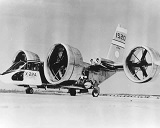
|
Bell X-22A Utility Flight Manual
309 pages
The Bell X-22 was an American V/STOL X-plane with four tilting ducted fans. Takeoff was to selectively occur either with the propellers tilted vertically upwards, or on a short runway with the nacelles tilted forward at approximately 45°. Additionally, the X-22 was to provide more insight into the tactical application of vertical takeoff troop transporters such as the preceding Hiller X-18 and the X-22 successor, the Bell XV-15.
The X-22 was eventually developed into the Bell-Boeing V-22 Osprey, which would not fly until 1989 (the X-22 project was first announced in 1962), but is still in service today (2016). |
XF-88B Voodoo
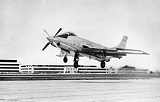
|
McDonnell XF-88B Voodoo Normal Operating Instructions
15 pages
The McDonnell XF-88 Voodoo was a long-range, twin-engine jet fighter aircraft with swept wings designed for the United States Air Force. Although it never entered service, its design was adapted for the subsequent supersonic F-101 Voodoo.
The XF-88 originated from a 1946 United States Army Air Forces requirement for a long-range "penetration fighter" to escort bombers to their targets. It was to be essentially a jet-powered replacement for the wartime North American P-51 Mustang that had escorted Boeing B-17 Flying Fortress bombers over Germany. It was to have a combat radius of 900 mi (1,450 km) and high performance. McDonnell began work on the aircraft, dubbed Model 36, on 1 April 1946. The Voodoo had a low/mid-mounted wing, swept to 35°. The two engines, specified as Westinghouse J34 turbojets were in the lower fuselage, fed by air intakes in the wing roots and jetpipes beneath the rear fuselage. This made room in the long fuselage for the fuel tanks required for the required long range. The Voodoo's short nose had no radar, being intended to house an armament of six 20 mm (.79 in) M39 cannon, while the fighter's single pilot sat in a pressurized cockpit and was provided with an ejection seat. This flight manual documents the XF-88B variant, which was a hybrid jet-turboprop. It was the first propellor-equipped aircraft to exceed Mach 1.0. |
Douglas YC-15
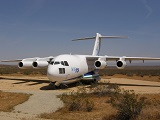
|
McDonnell Douglas YC-15 Utility Flight Manual
469 pages
The McDonnell Douglas YC-15 was a four-engine short take-off and landing (STOL) tactical transport. It was McDonnell Douglas' entrant into the United States Air Force's Advanced Medium STOL Transport (AMST) competition to replace the Lockheed C-130 Hercules as the USAF's standard STOL tactical transport. In the end, neither the YC-15 nor the Boeing YC-14 was ordered into production, although the YC-15's basic design would be used to form the successful C-17 Globemaster III.
Photo credit: Akradecki@wikipedia (CC-BY-SA 3.0) |
Northrop YF-23
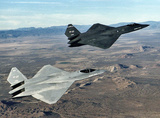
|
Northrop YF-23A Utility Flight Manual
199 pages
The Northrop/McDonnell Douglas YF-23 was an American single-seat, twin-engine fighter aircraft technology demonstrator designed for the United States Air Force (USAF). The design was a finalist in the USAF's Advanced Tactical Fighter (ATF) competition, battling the Lockheed YF-22 for a production contract. Two YF-23 prototypes were built with the nicknames Black Widow II and Gray Ghost. In the 1980s, the USAF began looking for a replacement for its fighter aircraft, especially to counter the USSR's advanced Sukhoi Su-27 and Mikoyan MiG-29. Several companies submitted design proposals; the USAF selected proposals from Northrop and Lockheed. Northrop teamed with McDonnell Douglas to develop the YF-23, while Lockheed, Boeing and General Dynamics developed the YF-22. The YF-23 was stealthier and faster, but less agile than its competitor. After a four-year development and evaluation process, the YF-22 was announced the winner in 1991 and entered production as the Lockheed Martin F-22 Raptor. The U.S. Navy considered using the production version of the ATF as the basis for a replacement to the F-14, but these plans were later canceled. The two YF-23 prototypes were museum exhibits as of 2009. The image to the left depicts the entire YF-23 production run in flight. |
Flying Wing
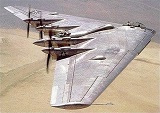
|
Northrop XB-35 Flight Manual
82 pages
The Northrop XB-35 and YB-35 were experimental heavy bomber aircraft developed by the Northrop Corporation for the United States Army Air Forces during and shortly after World War II. The airplane used the radical and potentially very efficient flying wing design, in which the tail section and fuselage are eliminated and all payload is carried in a thick wing. Only prototype and pre-production aircraft were built, although interest remained strong enough to warrant further development of the design as a jet bomber, under the designation YB-49.
|
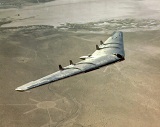
|
Northrop YB-49 Flight Manual
76 pages
The Northrop YB-49 was a prototype jet-powered heavy bomber aircraft developed by Northrop Corporation shortly after World War II for service with the U.S. Air Force. The YB-49 featured a flying wing design and was a jet-powered development of the earlier, piston-engined Northrop XB-35 and YB-35. The two YB-49s actually built were both converted YB-35 test aircraft.
The YB-49 never entered production, being passed over in favor of the more conventional Convair B-36 piston-driven design. Design work performed in the development of the YB-35 and YB-49 nonetheless proved to be valuable to Northrop decades later in the eventual development of the B-2 stealth bomber, which entered service in the early 1990s. |

|
Northrop YRB-49A Flight Operating Instructions
112 pages
One YRB-49A had been completed when, in September 1948, the Air Force ordered the type into full production as the RB-49A reconnaissance aircraft. It was powered by six jet engines, two of them externally mounted in under-wing pods, ruining the aircraft's sleek, aerodynamic lines, but extending its range by carrying additional fuel. The use of jet engines had resulted in considerably increased fuel consumption and decreased its range significantly.
During early 1950, the remaining YB-35Bs airframes being converted to YRB-49As were ordered scrapped. Flight testing of the sole remaining YB-49 prototype ended 14 March 1950. |
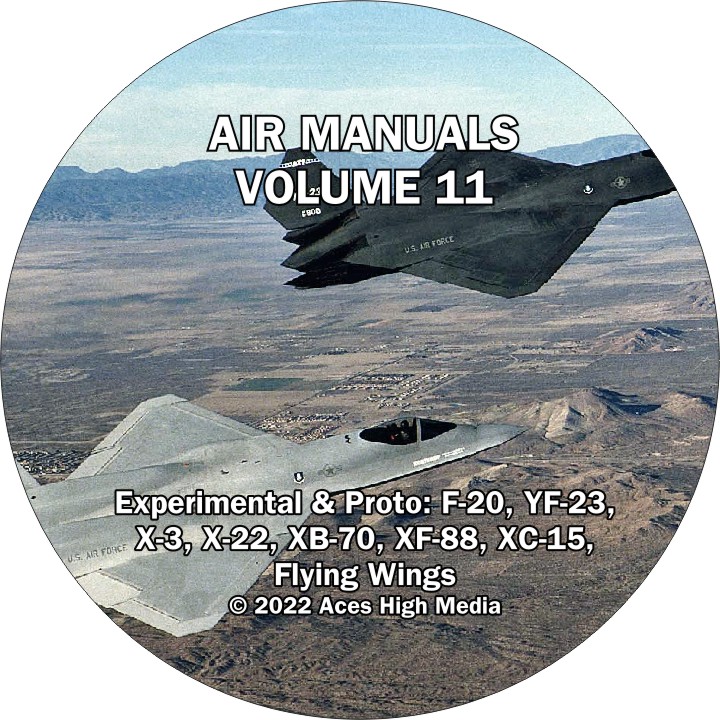

Much of the F-20's development was carried out under a US Department of Defense (DoD) project called "FX". FX sought to develop fighters that would be capable in combat with the latest Soviet aircraft, but excluding sensitive front-line technologies used by the United States Air Force's own aircraft. FX was a product of the Carter administration's military export policies, which aimed to provide foreign nations with high quality equipment without the risk of US front-line technology falling into Soviet hands. Northrop had high hopes for the F-20 in the international market, but policy changes following Ronald Reagan's election meant the F-20 had to compete for sales against aircraft like the F-16, then the USAF's latest fighter design. The development program was abandoned in 1986 after three prototypes had been built and a fourth partially completed.